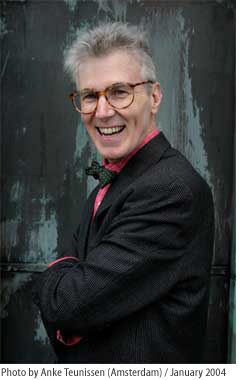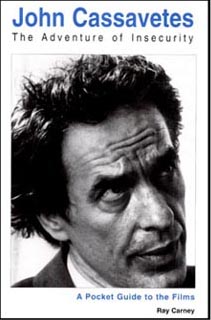The chronology
that follows covers the final ten years of John Cassavetes' life and
the nineteen years following his death. To access a chronology and
list of events covering the first forty years of Cassavetes' life, from
1929 through 1968, click
here.
To read more
about many of the events described below, go to the "About Ray
Carney" and the "Ray Carney's Discoveries" sections of
the site (in the left menu on this page) and the associated links. All
of the books and articles by Prof. Carney that are mentioned can be
purchased via the "Bookstore" link (also in the left menu
on this page).
1979-1990
/ 1990-1995
/ 1996-2000
/ 2001-2005
/ 2006-2007
2
< Page 3 < 4
Click
here for best printing of text
1996
Nick Cassavetes
films She's DeLovely with Sean Penn and Robin Wright Penn.
1997
August: After a series of preliminary publicity
events, Miramax gives Nick Cassavetes' She's So Lovely (a title
change required by the refusal of the Cole Porter estate to grant permission
for the use of the original title) a national release, representing
the heavily re - written and re - conceptualized film as "written by John
Cassavetes." To support the release, Miramax has Ray Carney organize
a six - film mini - retrospective of Cassavetes' work and create a 24 - page
souvenir program booklet and program guide, Love on the Edge. Carney
refuses to say anything positive about She's So Lovely in the
program. Click
here to read the catalogue and program notes Ray Carney created
specially for the tour. He organizes a celebrity panel discussion of
Cassavetes' legacy at New York's Paris Theater. The Cassavetes retrospective
plays to sell - out crowds in New York, Austin, and Chicago. She's
So Lovely receives lukewarm to negative reviews and to Miramax's
surprise does less business in the three cities than the authentic Cassavetes
films.
1998
February: The first web site devoted to Cassavetes'
life and work is established by Ray Carney at: www.Cassavetes.com. Carney
includes announcements about his search for the first version of Shadows.
July: Ray Carney receives
a call from a company in charge of the liquidation
of a discontinued film warehouse. He is offered cans of Cassavetes'
films, some of which have been sitting in storage unclaimed for as long
as forty years. Since he does not have adequate storage or preservation
facilities, Carney declines the gift and instructs the company to contact
the Motion Picture Division of the Library of Congress. It will turn
out that a lost long print of Faces is among the material. Click
here for more information about this print.
 October 30 - 31: Ray
Carney introduces screenings of Shadows
and the long version of The Killing of a Chinese Bookie and conducts
question - and - answer sessions at the Virginia Film Festival.
October 30 - 31: Ray
Carney introduces screenings of Shadows
and the long version of The Killing of a Chinese Bookie and conducts
question - and - answer sessions at the Virginia Film Festival.
Carney talks to Rosemary C. Hanes, an administrator at the Library
of Congress, who verifies that she has recently obtained physical possession
of but not inspected or catalogued the unclaimed cans of film that Carney
recommended be turned over to the Library.
1999 - 2001
Ray
Carney serves as the scholarly advisor for Charles Kiselyak's
documentary about the life and work of John Cassavetes, A Constant
Forge. Among other material, he provides an unpublished draft of
his Cassavetes on Cassavetes manuscript only to learn later that
its text is being used as the voice - over narrative to the film without
payment or permission. As the scholarly advisor, he also objects to
the sentimentality of the film and the choice of interviewees, but his
advice is ignored. Rowlands expresses pleasure with the film. Click
here for a more complete account of Ray Carney's involvement with the Kiselyak
film and more information about the misappropriation of Carney's material
and the denial of scholarly credit.
Over
a period of years, Shaw Photographics periodically
protests Gena Rowlands's
unauthorized use of Sam Shaw's photographs, posters, and layouts in
various projects including Charles Kiselyak's
film, the Criterion box set, and other publicity for Cassavetes' work.
Rowlands claims that Sam Shaw was "an employee" and that that she consequently
owns the photographs he took on the sets of Cassavetes' films and most
of his other Cassavetes - related work and does not need to ask permission
or pay to use them.
1999
March: Ray Carney presents "An Evening with John Cassavetes," screening unreleased,
unknown, and unavailable film clips and videotapes showing Cassavetes
acting, rehearsing actors, and talking about his work at the Danish
Film House in Copenhagen, Denmark.
 May:
After being turned down by several publishers due to lack of interest
in Cassavetes, Ray Carney self - publishes John Cassavetes: The Adventure of Insecurity. The first printing sells out
and a revised second edition is issued in September 2000.
May:
After being turned down by several publishers due to lack of interest
in Cassavetes, Ray Carney self - publishes John Cassavetes: The Adventure of Insecurity. The first printing sells out
and a revised second edition is issued in September 2000.
June:
As a representative of the U.S. Department of State and a guest
of the Sydney and Melbourne Film Festivals and associated universities,
Ray Carney presents a retrospective of Cassavetes' acting and directing
work in Sydney, Canberra, and Melbourne, Australia.
He introduces the screenings, moderates question - and - answer sessions,
and participates in panel discussions about Cassavetes' work before
more than ten thousand people. He also speaks about Cassavetes on Australian
television and radio.
May - July: The Special Projects Division of Pioneer
Electronics releases the second version of Shadows, Faces,
A Woman Under the Influence, the short second version of The Killing of a Chinese Bookie
(the only version Rowlands and Ruban will
allow to be released), and Opening Night on laserdisc
and DVD. Ray Carney writes the program notes. In his
essay to accompany the Shadows disk, Carney presents his preliminary
conclusions concerning the content of the first version of the film.
Due
to the low quality of the transfer and the lack of video supplementary
material or voice - over commentary, Film Comment votes the release
one of the "ten worst DVD sets" of all time. Due to weak sales, Pioneer
lets the disks go out of print and does not renew their license to distribute
them.
2000
- 2003
Ross
Lipman, chief preservationist for the UCLA Film and Television
Archive, supervises the restoration of Shadows. He consults with
Ray Carney, who reveals many previously unknown facts to him, for example,
that the negative in his possession is from the second version of the
film and that the footage in it was shot at two different periods of
time. Carney provides Lipman with a detailed,
unpublished shot list documenting details of which shots were from which
period of shooting, and keeps Lipman updated
as his own research uncovers new facts about the two versions. He also
tells him about and keeps him informed of the progress of his search
for the first version of Shadows. Lipman
tells Carney that Al Ruban, whom Lipman
frequently deals with, vehemently denies the existence of a first version
of the film and ridicules Carney's search for it.
2000
September 29 - October 4: Ray Carney introduces a week - long retrospective
of the films of John Cassavetes at the Harvard Film Archive. On the
final night, he presents an evening - length event titled: "The Unknown
John Cassavetes: Behind the Scenes," in which he screens unknown and
previously unavailable television acting performances and other work
by and about Cassavetes in his private collection. Most pieces are being
shown for the first time since their original broadcasts and several
are being given their American or world premieres. Films and video titles
shown in whole or in part include: Tamara Simon Hoff's The Haircut;
Charles Cohen's Flip - Side (which was given its American premiere);
S. Lee Pogostin's "Free of Charge"
(a thought to be lost work); the "Faces" episode of Andre Labarthe's
Cineaste de Notre Temps; Tristram Powell's "Making of Husbands" documentary
(shown in an uncut version different from the shorter one broadcast
on PBS); Cassavetes, Falk, and Gazzara's appearances
on The David Frost and Dick Cavett
shows; and several never previously broadcast videos in which Cassavetes
talks about his films and works with actors.
2
< Page 3 < 4
1979-1990
/ 1990-1995
/ 1996-2000
/ 2001-2005
/ 2006-2007
The chronology
above covers the final ten years of John Cassavetes' life and the nineteen years following his death. To access a chronology and list of events
covering the first forty years of Cassavetes' life, from 1929 through
1968, click
here.
To read more
about many of the events described above, go to the "About Ray Carney"
and the "Ray Carney's Discoveries" sections of the site (in
the left menu on this page) and the associated links. All of the books
and articles by Prof. Carney that are mentioned can be purchased via
the "Bookstore" link (also in the left menu on this page).










